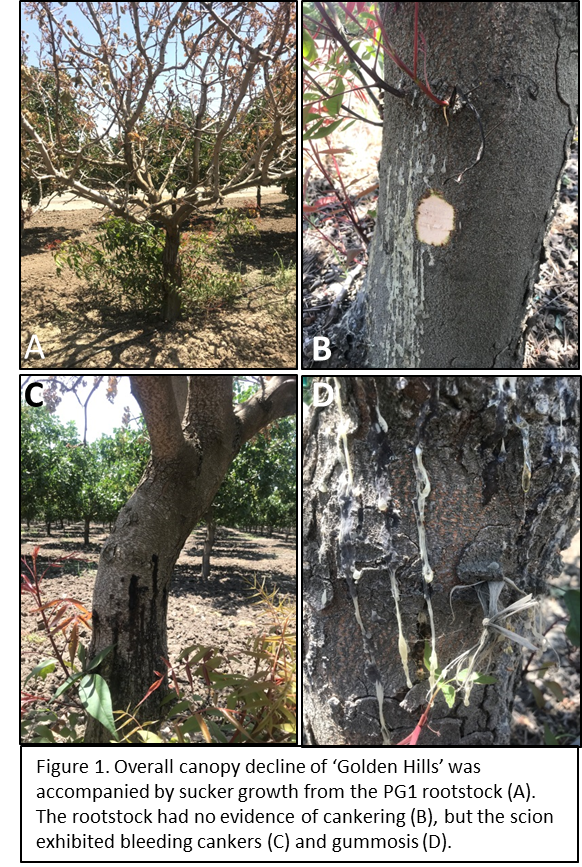It is not often that we observe cankers caused by Phytophthora on pistachio in CA; however, the unique situation observed on a recent farm call is worth recounting. The decline and mortality (Figure 1A) of approximately 20 trees in a Tulare County pistachio block of ‘Golden Hills' on PG1 rootstock (a selection of Pistacia integerrima) was unusual simply because we generally find PG1 rootstock to be resistant to Phytophthora. In fact, the rootstock did not exhibit any symptoms of cankering and the cambium appeared healthy (Figure 1B). Rootstock suckers were actively growing, suggesting that the pathogen was not infecting the roots or crown of the tree (Figure 1A). The scion, however, exhibited extensive bleeding (Figure 1C) and gummosis (Figure 1D), which is typical of Phytophthora infection on Pistacia vera.
The diagnosis of this problem was possible only after gathering information from the grower on orchard management history. Recently the grower had changed the microsprinkler nozzles to a higher flow rate nozzle (14 gallon/hr). The stream of water from the microsprinkers was wetting the trees above the graft union. Additionally, the grower had recently utilized surface water (not ground water) for irrigation. Surface water has a high probability of Phytophthora contamination. The combination of the change to higher flow rate sprinklers, wetting of the scion wood, and risk of introduction of Phytophthora to the orchard, all suggested that the cankering, canopy decline, and mortality is related to Phytophthora infection. After sampling the canker tissue and incubating it in selective medium, the presence of Phytophthora sp. was confirmed in the tissue.
To prevent further incidence of Phytophthora in the orchard, the irrigation system needs to be changed to prevent water from splashing on the tree trunks. This may include both changing the nozzles to a lower flow rate, and moving sprinklers further from the base of trees. As long as the water does not touch the susceptible P. vera scion, the introduction of Phytophthora to the orchard in surface water is of minimal risk to orchard health. In order to preserve the rootstock and enhance regeneration of productive, economically viable trees, the grower may opt to cut the scion off to a point below the graft union and re-graft onto the mature rootstock.
The grower may also opt to run products through the irrigation system that may assist with disease management. Two examples of products that have been found to prevent Oomycete infection on pistachio and other crops include phosphites and Ascophyllum nodosum extract. Replicated trials using K-PHITE 7LP (Plant Food Company, Inc) and Acadian (Acadian Seaplants) have demonstrated that both product types offer protection of pistachio from infection by Phytopythium helicoides (another Oomycete causing root rot on pistachio and almond), and therefore may have value in mitigating future infections within the orchard. K-PHITE 7LP is labeled for management of Phytophthora on pistachio. Acadian, an extract of A. nodosum, is registered as a fertilizer; however, the efficacy of A. nodosum extract in mitigating plant diseases, including those caused by Oomycetes, is well documented in the scientific literature.
For more information on management of Phytophthora, visit UC IPM Online (www.ipm.ucdavis.edu). Always read the label of the product being used, and note that all registered pesticides are not necessarily listed on the UC IPM Online website (http://www.ipm.ucdavis.edu) or in this newsletter. Always check with certifier to determine which products are organically acceptable.
